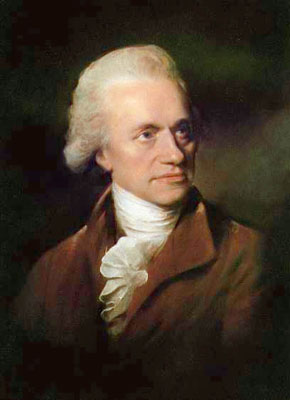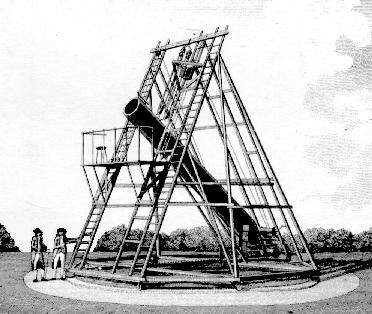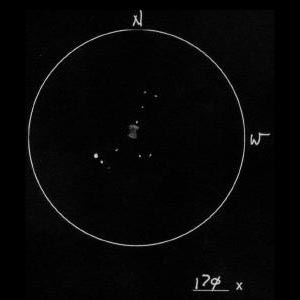
In 1783 Sir William Herschel began his historic search of the heavens. Primariliy using a 18.7" telescope he systematically recorded 2514 deep sky objects, most of these were original discoveries. While his list does contain a few errors, it was the first large scale search of the heavens and formed the start of the New General Catalog still in use today.
Herschel had become quite famous for the discovery of Neptune, the first planet discovered in modern times and the first found with a telescope, a modest 6" instrument of his own manufacture. The ability to make his own instruments proved to be a major advantage Herschel had over the other observers of his day, he could make bigger instruments of higher quality with which to view the heavens. The quality of these instruments is testified to in his descriptions, where Messier saw a hazy glow, Herschel saw the points of innumerable stars. With the discovery of Neptune he was awarded a pension by the English Crown and was able to devote himself full time to the manufacture of ever better and larger telescopes, and nightly used these instruments to survey the heavens.
This work was greatly aided by William's sister Caroline Herschel, who did much of the compilation and data reduction necessary to record the positions of William's discoveries. Later Williams son John Herschel continued his father's work, taking the 20ft telescope to South Africa to complete his father's survey by extending it to the entire sphere of the heavens
The discoveries of William and John Herschel as well as from others of the day were compiled into the General Catalogue. As the pace of discovery continues this catalog was quickly outdated and the Irish astronomer, Dreyer, used it as the staring point for the compilation of the New General Cataloge, a work containing over ten thousand nebulae, galaxies, and clusters, a work still in use today.
More information...

(public domain image)
To allow modern observers to follow in the footsteps of Sir William Herschel without taking on the whole list of 2500 objects Brenda Branchett selected the 400 best of these objects to form the Herschel 400 for the Astronomical League. The League issues an award for any member who observes the entire list.
Tracking down these 400 objects is considered an advanced exercise even among experienced observers. The objects range in brightness from magnitude 5 to 14 and include galaxies, nebula, planetary nebula, as well as open and globular clusters of stars. These objects can all be found in a modest amateur telescope but to truly appreciate the list an instrument of 30cm (12") or better is helpful.
The process of observing the entire list is a lengthy but rewarding one. There are many unobtrusive, and fairly dim galaxies on the list, working my way through the constellations of Virgo, Canes Venatici or Ursa Major could get fairly dull. But every few objects I would come across a true gem, an interesting galaxy with great structure or a cluster of galaxies filling the field. I gained a far better understanding of the distribution of objects and an appreciation for the universe I never had before. The true immensity of space was laid out before my eyes, galaxy after galaxy, each representing a billion or so stars, and here were dozens of bright galaxies and clusters of galaxies everywhere I looked. Beside the brighter 10th or 11th magnitude galaxies there were often two or six dim galaxies in the field of the eyepiece. Infinity indeed.
Not that there are only galaxies on the list, there are dozens of nebulae, globular and open clusters. These tell a similar tale about the immensity of our own galaxy, of the billions of stars that make the Milky Way a medium sized spiral. The H400 was for me a lesson like no other in the true nature of the universe, the vastness. You can not simply go from object to object and check them off the list, after a while the reality of what you are looking at begins to translate those dull fact and numbers in the astronomy textbook into a reality, a dim understanding of true immensity.

